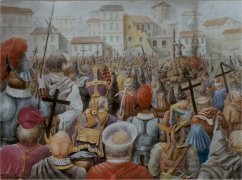Rome, 1597
From the Vatican Secret Archives

Paper volume, 320x240mm, ff. 429 (ancient, partly wrong numbering and not inclusive of many white folios), bound in parchment; on the back: VARIA. Censurae.
ASV, Misc., Arm. X, 205, ff. 230v‑231r
In one of the volumes of the fond “Miscellanea Armadi” (Arm. X, 205), maybe made up of the collection of different documents by the famous canonist Francisco Peña, Auditor and then Dean of the Rota (he died in 1612), there is a precious document, searched for a long time, then kept secret for a long time and finally found on the 15th November 1940 in the Pius IX fond after 15 years of unsuccessful investigation by the Prefect of the Vatican Archives, Angelo Mercati: the summary of the trial against Giordano Bruno. Thanks to Angelo Mercati, the summary was published, with a long and sound introduction issued in 1942.
Since the volume or the volumes of the Roman trial against Giordano Bruno (1548-1600), once kept in the archives of the Holy Office, were irremediably lost, this document, which derives from the originals (on the margins of the document you often find citations of the pages of the lost trial), is the most precious testimonies we have to understand the long and troublesome inquisitorial event the famous Dominican friar underwent. Some abstracts of Giordano Bruno’s works, his interrogations, some of the records of the Venetian trial in 1592 against the famous preacher and some other documents copied from the original trial converged in the summary, which was probably used by the Assessor of the Holy Office of that period.
The humane vicissitudes of Giordano Bruno ended with the Roman trial (1593-1600) and with the sentence of proven heresy, which, due to his resolute and extreme statement of not being guilty, changed into capital punishment, executed at Campo de’ Fiori on the 17th February 1600. In one of the last interrogations before the execution of the sentence (maybe in April 1599), the Dominican friar was questioned by the judges of the Holy Office on his cosmogony conception, supported above all in the “La cena delle Ceneri”(Ash-Wednesday Dinner) and in the “De l’infinito universo et mundi”. Even then, he defended his theories as scientifically founded and by no means against the Holy Scriptures (left side, from the first line: Circa motum terrae, f. 287, sic dicit: Prima generalmente dico ch’il moo et la cosa del moto della terra e della immobilità del firmamento o cielo sono da me prodotte con le sue raggioni et autorità le quali sono certe, e non pregiudicano all’autorità della divina scrittura [...]. Quanto al sole dico che niente manco nasce e tramonta, né lo vedemo nascere e tramontare, perché la terra se gira circa il proprio centro, che s’intenda nascere e tramontare [... ]). (Circa motum terrae, f. 287, sic dicit: Firstly, I say that the theories on the movement of the earth and on the immobility of the firmament or sky are by me produced on a reasoned and sure basis, which doesn’t undermine the authority of the Holy Sciptures […]. With regard to the sun, I say that it doesn’t rise or set, nor do we see it rise or set, because, if the earth rotates on his axis, what do we mean by rising and setting[…]).
In the same rooms where Giordano Bruno was questioned, for the same important reasons of the relationship between science and faith, at the dawning of the new astronomy and at the decline of Aristotle’s philosophy, sixteen years later, Cardinal Bellarmino, who then contested Bruno’s heretical theses, summoned Galileo Galilei, who also faced a famous inquisitorial trial, which, luckily for him, ended with a simple abjuration.
